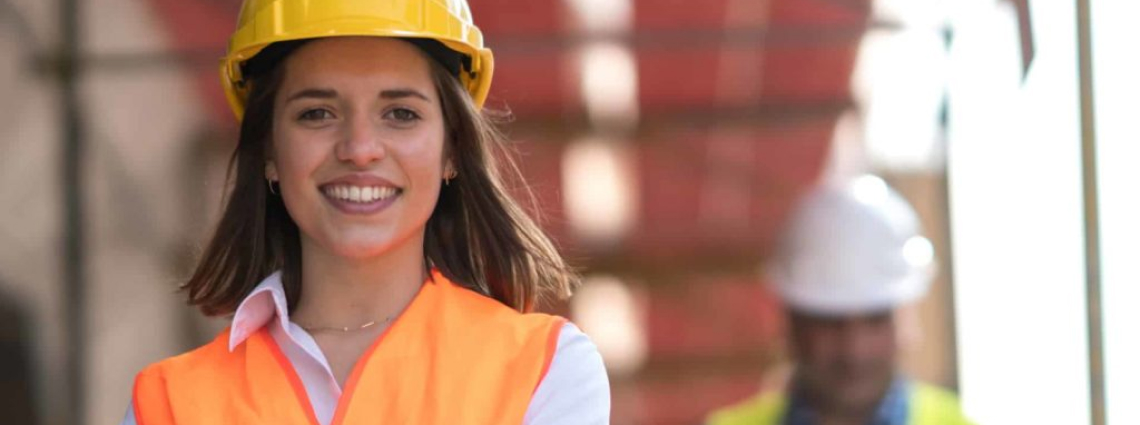
Women in construction don’t always get a fair go in the building industry. Let’s talk about how we all benefit from smashing barriers to create more supportive workplaces with higher profits.
—
Step onto any building site and you’ll see it:
Women are usually outnumbered by men.
In the Australian construction industry, women make up only 12 per cent of the workforce.
And this gap is getting worse, not better.
This probably wouldn’t matter, if it wasn’t for the fact that many women WANT to work in construction.
Unfortunately, various barriers stop them from getting in and sticking around – although many of these are unintentional.
Our industry isn’t tapping into one half of the population to expand its dwindling workforce, even as businesses struggle to fill job vacancies amidst widespread skills shortages.
Now more than ever, we need to attract and retain anyone who’s a good fit.
Contents
Fresh ideas, lower turnover and extra hands on deck to boost productivity. Everyone in the industry benefits when qualified women join construction teams, feel good about their jobs and enjoy rewarding careers.
Businesses with more gender diversity in their ranks (especially at the executive level) usually perform better than their competitors.
And we’re not talking about a small advantage either.
Research by McKinsey & Company shows that gender diverse companies come out on top, time and time again:
This is supported by Catalyst data that reveals companies with a higher percentage of female leaders outperform those on the low end of the spectrum by 26 per cent, when it comes to return on invested capital.
Their shareholders also enjoy a 34 per cent higher total return, according to another study.
This is impressive.
But what are the benefits to people on the “front line” (the workers)?
Everyone wins when there are more women on the team.
Dr Phillippa Carnemolla is an industrial designer and senior research fellow at the University of Technology Sydney. She discovered that gender diversity in the workplace improves the wellbeing of both women and men.
She told Infrastructure Magazine:
“In our workplace, having better diversity in teams leads to improved problem solving and innovation, and workplaces where everyone feels they belong and can contribute equally. It also addresses the skills shortage our sector faces and improves the sector’s gender pay gap. It’s good for men too. The business case for diversity has been documented in reports internationally.”
The fact that men also benefit from gender diversity shouldn’t be taken lightly, considering the building sector has a problem with mental health. We already know that construction workers are more than twice as likely to end their lives, compared to the rest of the population.
Devastating.
Much of this comes down to the fact that depressed men are reluctant to seek life-saving support because they don’t want to appear weak.
Perhaps it’s time to soften the edges of our industry?
Higher numbers of women in building jobs could help to foster an environment where everyone feels supported. Evidence shows that team collaboration drastically improves with the presence of women, so it’s expected that employees would work better together too.
Now, let’s look at some of the barriers that Australian women in design and construction face.
“Why would I want to be in the construction industry? No one would listen to me because I am a girl.” High school student
Few girls in high school can imagine working in the building sector.
They don’t realise there’s a diverse scope of jobs under the construction umbrella.
It doesn’t help that parents and teachers don’t recommend these options to female students, with the exception of STEM careers like engineering and architecture.
These are some of the findings from Dr Phillippa Carnemolla’s research into the topic, based on interviews with year 11 students from an all-girls school in Sydney:
“Their perceptions of other women in the construction career were limited to ‘lollipop’ holding and traffic management, with many stating that they do not know any women at executive levels in the construction industry and could not visualise themselves or their friends achieving in the sector.”
It’s hardly surprising that so few women opt to learn a construction trade or profession at university or TAFE, given these perceptions.
Take the construction project management degree at UTS, for example:
Dr Carnemolla’s report can be found here, if you’re interested in reading more.
Sometimes there isn’t enough support for female construction students:
Here’s an example:
Amanda Bulow, founder of Awesome Women in Construction, told Jobsite the story of one woman who’s completing her TAFE studies at home because there are no female toilets where her trade classes are. The lighting at night is also inadequate, so she doesn’t feel safe.
Bulow says the industry needs to make studying construction more appealing to women.
There also needs to be more female role models.
Unfortunately, there aren’t enough female construction workers to mentor students – since so few women work in the industry. This is a shame, considering that many women who undertake construction training do so because they’ve been influenced by female construction workers.
Case in point:
A US study by Dr Ben Bigelow looks at the best ways to attract female students to construction management courses. Around 41 per cent of participants said a female role model positively influenced their decision to study CM, which isn’t insignificant.
Building companies often make hiring decisions based on referrals from their predominantly male workforce.
Women generally miss out on these job opportunities because they’re less involved in the informal networks frequented by men. According to research by UNSW, women tend to submit their applications via official recruitment channels that are less valued by building companies (such as online job boards and newspaper advertisements).
“I studied construction management and spent 15 years delivering building, civil, defence and mining projects in Australia and the Middle East and North Africa for large contractors. I found it very difficult to progress within construction companies, despite being one of the few women in an operational role and working very hard.”
Dr Natalie Galea (Infrastructure Magazine)
Source: Infrastructure Magazine
Females in the building, property and engineering industry rarely occupy on-site or senior management positions – mostly getting paid for admin, HR and other support roles instead.
This is a problem for 30 per cent of women who were interviewed by a Randstad-commissioned survey. They say they’re being passed over for new opportunities because of their gender.
Why is this happening?
Long working hours
Long hours are a normal part of being a construction worker, but this takes its toll on women and men alike. People in construction trades work some of the longest hours in Australia, with one in four regularly clocking in up to 50 hours a week.
There’s a significant amount of night and weekend work involved, as well as travel.
This makes it difficult for employees and contractors to balance their work with domestic and parental duties – the bulk of which falls on the shoulders of women; who are often overlooked for opportunities because they’re not able to make the same labour commitments as their male counterparts.
Focus on how construction projects help communities:
Research suggests that female students tend to be more interested in broader issues, compared to males.
The best way to attract female students to STEM classes is to highlight these elements when promoting construction courses, according to a US study by Dr Ben Bigelow.
Career advisors and school counsellors should also learn more about different construction careers, so they can confidently tell high school students that it’s possible to enjoy a successful and fulfilling career.
On-site visits help high school students to explore construction careers:
In cases where this isn’t possible, why not take a virtual tour with specialised headsets?
Dr Fiona Lamari from the Queensland University of Technology invented the Virtual Construction Site Tour. This exposes high school girls to various career options and shows them what happens on a construction site via virtual technology.
“Ultimately this is about changing perceptions of the construction industry. I developed the Virtual Construction Site Tour to allow students to step on to a construction site and meet with influential and diverse role models.”
Dr Fiona Lamari, Lecturer in Construction Management
The Virtual Construction Site Tour is part of the NAWIC QLD In-Schools Experience Program. Contact Dr Fiona Lamari if you’d like to find out more.
Avoid gendered wording in job advertisements:
Although it’s unlawful to discriminate on the basis of sex, research shows that many job advertisements contain subtle words that exclude a particular gender, even if unintended. For example, advertisements in male-dominated industries are more likely to contain stereotypically masculine words, which inadvertently deters women from applying.
Managers need to be mindful of bias in all stages of recruiting (not just job ads):
Unconscious gender bias is prevalent in every stage of the recruitment process, according to the Workplace Gender Equality Agency. All hiring managers should read this eye-opening study, which highlights the different ways that men are favoured during recruitment.
Many women in construction would benefit from “soft skills” workshops that help them to confidently navigate the workplace and successfully negotiate flexible working arrangements.
“Realising their own self-confidence and self-worth is the real issue. I see many women in the industry who are leading the way for the next generation, and they just can’t see the enormous value they are adding to the industry. We are trying to change this via workshops and providing a supportive community at AWIC.”
Amanda Bulow, founder and chairperson of Awesome Women in Construction, quoted in Jobsite
We talked about this earlier:
Many women who study construction have been influenced by a female already working in the industry.
Companies can introduce structured female mentorship programs that attract high school students to the sector and guide career progression. However, this probably won’t be effective until more women are employed in the sector.
A lot of progress is already happening.
Some large construction companies are piloting flexibility initiatives, childcare rebate provisions and paid parental leave, according to a report by the University of New South Wales.
Researchers want the industry to:
Most importantly, men and women alike benefit from greater workplace flexibility.
Here’s an example:
The results?
Employee engagement increased to 90% by 2018 – with recruits citing this new approach as one of the top four reasons why they wanted to join Mirvac.
It’s important that women in engineering, architecture and building jobs have the opportunity to attend networking events to build connections, support each other and find out about industry developments. Awesome Women in Construction (AWIC) is a non-profit association that organises such events.



© Copyright 2022 TPM Builders. All rights reserved.